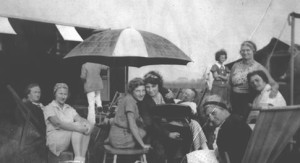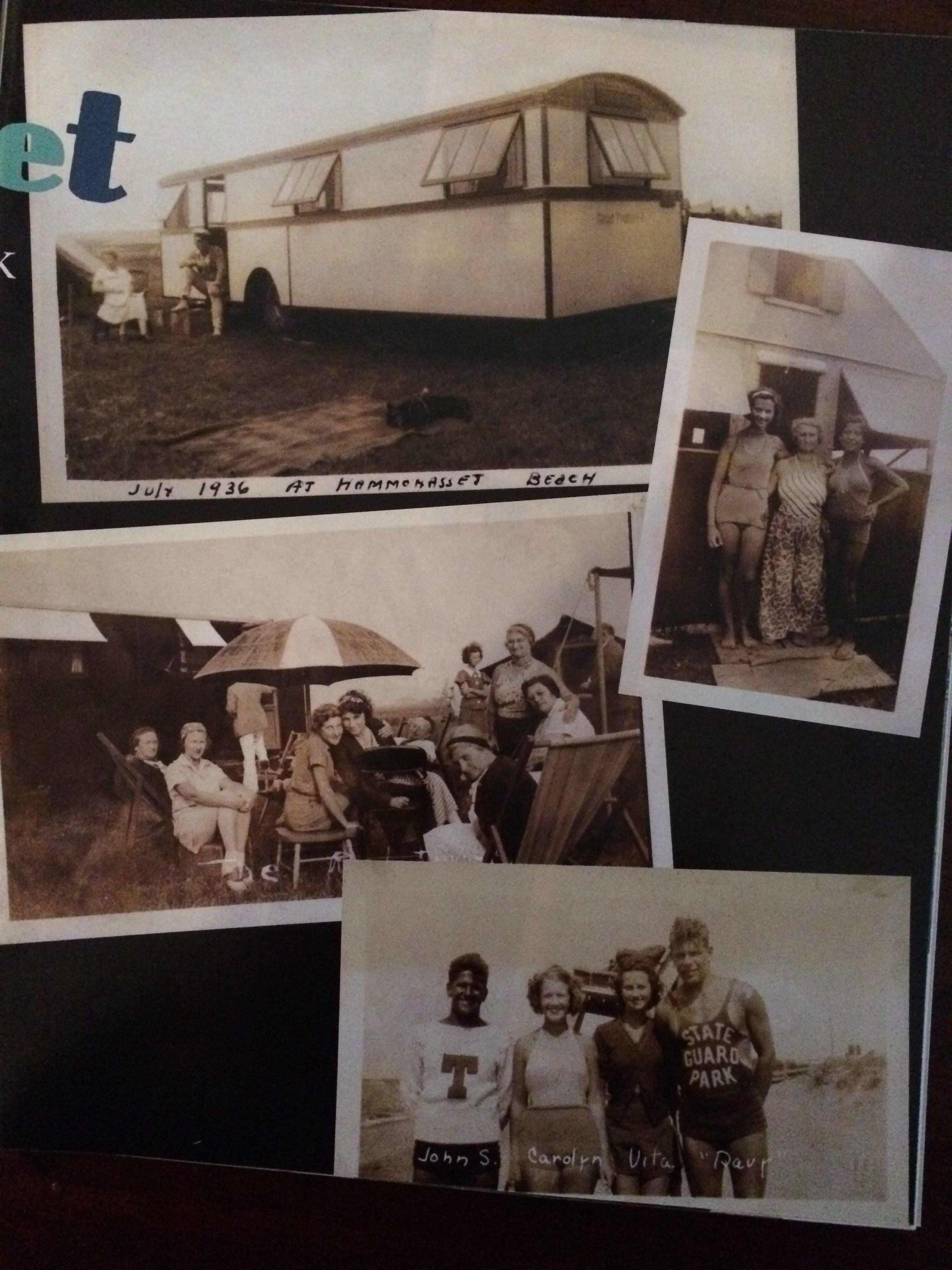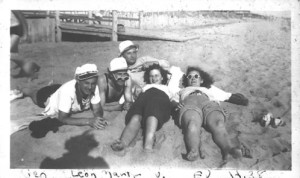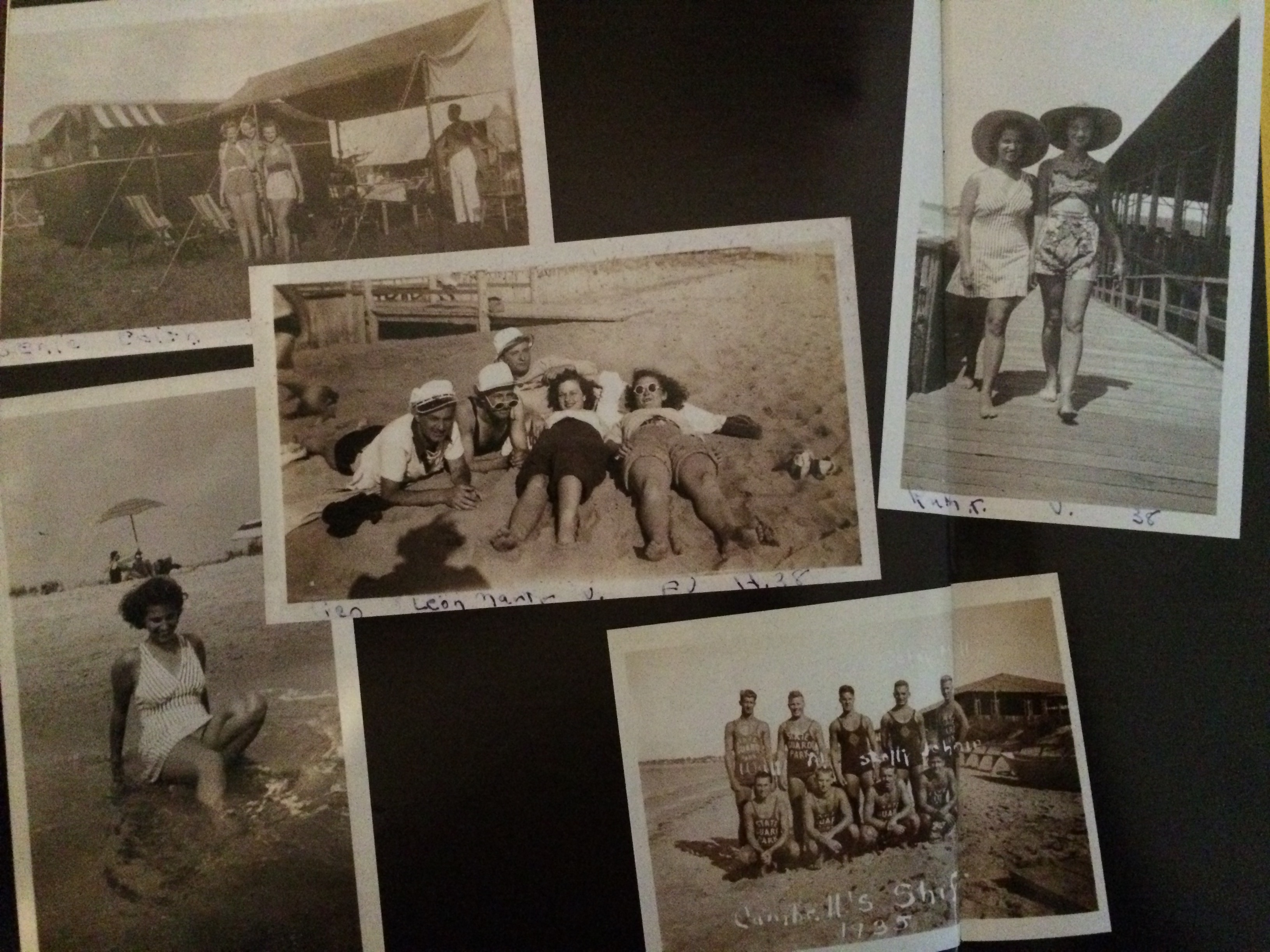by Terry Gellin
(c) Connecticut Explored Inc. SUMMER 2006
Subscribe/Buy the Issue!
These pictures from the 1930s are from a photo album belonging to Vita Falk Gellin, my mother. Her family summered for many years at Hammonasset Beach State Park . When I asked her recently to tell me about the pictures, my 85-year-old mother’s voice perked up. This is what she told me of her “wonderful summers” at Hammonasset State Park. 
Vita’s father, Elias Falk, built a trailer in Hartford and then transported it to Hammonasset. Going up the hill in Middletown was tough. Other family members had built a home in Watch Hill, but Elias thought that was “too rich” and decided camping was more to his liking. He had quite a mechanical and creative flair and held a patent that prevented trucks from skidding. When the front wheels hit ice, sand would drop so the rear wheels wouldn’t skid.
The trailer had no indoor plumbing. Water was available at a central location nearby. There was a pole with a faucet so one could fill up containers. Elias took a barrel, poked holes in it, and attached it to a post to use as a shower.
The lifeguards, all state employees, were wonderful and taught Vita to swim when she was five or six. She also remembered a polio scare: her family was told to stay at the beach rather than come back to Hartford at the end of the summer. She couldn’t recall the year.
Many years later, my sisters Sharon and Judy and I also spent time at the family campsite. It seemed like we had the whole place to ourselves. I never thought of it as a state park. Sharon recalled, “The camp always had a year-end “field day” with competitions like one-legged races and potato sack races. And the beach was special. It seemed so different from other Connecticut beaches. And so much of that remains the same today.”
Judy recalled, “Gram and Gramps first had a platform tent at a camp site. Then they graduated to a small trailer at a ‘camp’ with an outhouse. They added a living room and still had the outhouse. I remember the kerosene heater, and today, whenever I smell kerosene, I’m immediately transported back to the little cottage at Hammonasset. Eventually a new bedroom and indoor plumbing were added!”
Judy continued, “About 20 years ago I worked with a woman who had a small cottage at the same camp. The cottages were still small, and still in that same warren of tiny plots and many streets. I struggled to find Gram and Gramps’s place. Even when I was going there regularly it was hard to wander through the maze and get where you needed to go with the narrow one-way streets.
A Brief History of Hammonasset Beach State Park
By Elizabeth Normen
By 1913, the State of Connecticut recognized the need to purchase open space and create state parks and forest preserves while large tracts of undeveloped land were still available at a reasonable cost. Already, shoreline property was being rapidly developed. Five shoreline sites were identified in 1914, and in 1919 the Connecticut Park and Forest Commission purchased 75 parcels in Madison totaling 565 acres (about half of the present acreage). The state planned to assemble parcels between Tom’s Creek and the Hammonasset River–a tract that when completed would offer two uninterrupted miles of sandy beach.
The park opened to the public on May 30, 1921 with a grand pavilion, a boardwalk, and short-term (weekend) and long-term camping. The Clamshed, offering clam chowder, hotdogs, doughnuts, pie, coffee, and tea, and the like opened for the second season.
Another large and desirable parcel had been assembled at Meigs Point. The Winchester Repeating Arms Company in New Haven had used the property since 1898 as a rifle range. The state secured a right of first refusal should anyone offer to purchase the property. Two years after opening, with the park an immediate success, Winchester received an offer to purchase the 350-acre property for development as resort and hotel. Though it had the right of first refusal, the state did not have the $55,000 purchase price. Fortunately, J. Harris Whittemore, a park commissioner, Naugatuck industrialist, and philanthropist, bought the property and leased it back to the state; the state finally purchased it from him in 1925.
From the very first season, camping was popular, and the camping areas were expanded several times over the next decades. Initially, each long-term site had an outhouse and a water spigot, and lights were strung on wires along the street. The camps were policed and garbage picked up daily. Long-term campers paid 50 cents a day; the short-term sites were free. In the early 1930s, improvements were made, including shared flush-toilet facilities with running water and lighting from a central pole. Giving a glimpse of why such improvements were needed, the park’s 1932 biennial report noted these central bathrooms “would then be plainly in charge of state park employees and not left to such care as the campers might give them.”
During the 1932 season, 1,515 people from 69 towns and 12 states summered at the long-term camp sites. Another 10,900 people camped in the short-term sites, and nearly 178,000 people visited the park. During the Depression, the camp sites continued to be filled to capacity. Though the park was heavily damaged by the hurricane on September 21, 1938, the park reopened the following summer after extensive restoration by the federal government’s Works Progress Administration (WPA).
Much of the history recounted here is drawn from The History of Hammonasset State Park by Gary Dunn (1974), courtesy of the Charlotte L. Everts Memorial Archives, Madison, Connecticut.



